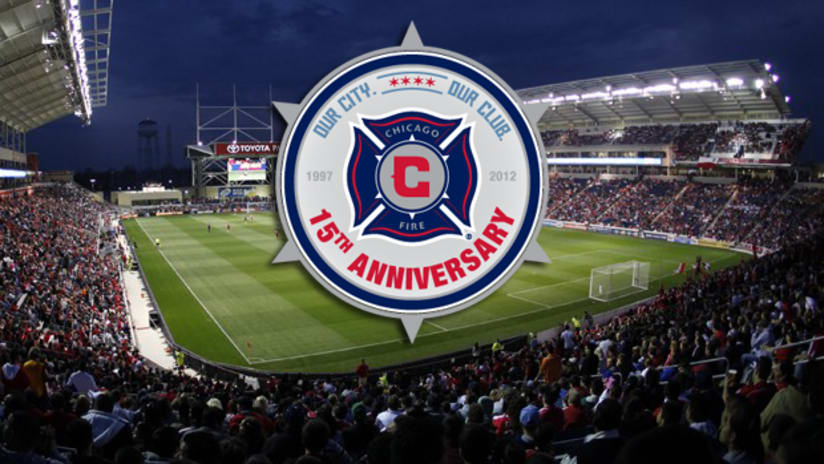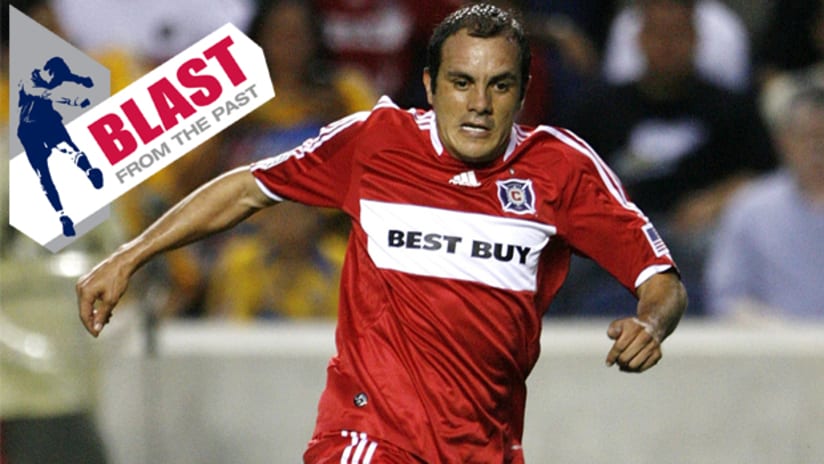(Photo Credit: Conrad Akier)
We are chewing down on some quite delicious pizza at Piece restaurant in Wicker Park, and a certain silver-haired Greek-American is practically bouncing off the walls.
When Frank Klopas is animated about something, everyone in his vicinity has little choice to not only be very much aware of it, but to embrace it: I’ve never seen one of his half-time team talks, but I can only imagine that there isn’t anywhere to hide, that Frank’s 45 minutes of side-line pacing builds into an unavoidably exuberant “talk.” Maybe I’m wrong, but that’s what I like to think goes on in the locker-room when Frank’s in charge.
What I do know for sure is that on this particular evening in the summer of 2009 – when, of course, he was not the Fire’s coach but instead its technical director – Frank had a real bee in his bonnet. The Ring of Fire member and Chicagoan wanted to know why we didn’t do more to celebrate the Club’s birthday on October 8th. It was a tie that could bind the Fire community’s past and present together, Frank said, and one that uniquely linked the Club to the City (OK, I’m paraphrasing; Frank’s enthusiasm is such that I’d need more words than you want to read to actually piece together the whole conversation).
You’re right, Frank, we said. Let’s do something on October 8th. We only have a few weeks (it was late August, if I recall correctly), but if there’s one thing those of us in Section 8 can do, it’s scratch together an event on short notice by drawing on the collective willingness of slightly unhinged fanatics to volunteer and pull together when the inspiration strikes.
And strike it did. Why wouldn’t we celebrate every October 8th? After all, whatever the ups-and-downs of the Club, the one thing anyone who says they are “Fire til I die” with a straight face ought to be keen to honor is the date of the club’s founding, the name of the Chicago Fire Soccer Club announced on a Fall day at Navy Pier back in 1997 on October 8th.
The date, you probably know, was not chosen by accident. It was 126 years earlier, October 8th 1871, that Chicago was set ablaze not for the first or last time, but for the defining time: a conflagration that tore a city asunder, only for its survivors to respond by building a city greater than anyone could ever have imagined possible.
“Flames! Flames! Terrible flames! What a fearful destruction they bring. What suf'fring and want in their train follow fast, As forth on the streets homeless thousands are cast. But courage! Courage! From the mid'st of the furnace we sing.”
Those words written by George S. Root come from the Chicago History Museum’s “Web of Memory,” a remarkable collection of contemporary accounts of the Great Chicago Fire. And sing Chicagoans did, of the tragedy and of survival and of reconstruction. A popular song soon emerged, one you may now hear in the Harlem End of Toyota Park, and it goes like this:
Late one night, when we were all in bed, Mrs. O'Leary lit a lantern in the shed. Her cow kicked it over, Then winked her eye and said, "There'll be a hot time in the old town tonight!"
With this kind of folklore building, Chicagoans had determined that, however it really started somewhere around 12th and Halsted Streets , the Great Fire that destroyed nearly 20,000 homes, left 90,000 homeless and killed 300 people would not be forgotten – and nor would the monumental rebuilding effort soon undertaken to remake the city. Within a week, 6,000 temporary structures housed the homeless, as the Tribune declared CHICAGO SHALL RISE AGAIN.
Every year, as the city continued to expand in the late nineteenth century, Chicagoans gathered on the Great Fire’s anniversary to show this city had not been cowed. As G.W. Steevens put it: “Therefore the men of Chicago resolved that the twenty-fifth anniversary of her destruction by fire should not pass without such a demonstration as should convince the world that she is very much more alive than ever.”
The annual celebration in October became known as Chicago Day, and editorials in the Chicago Tribune were accompanied by gleaming illustrations, beams of light shining from the resurrected city. Great monuments were proposed: one never built was designed by William LeBaroney Jenney (a key developer of the skyscraper), a tall tower crowned by a female figure clutching a flaming torch to symbolize – as the Tribune put it – “the triumph of energy and enterprise” in the wake of disaster.
In some ways, it is difficult now to grasp just how monumental Chicago’s survival and growth in the wake of the Great Fire seemed in the late nineteenth century. But for city boosters – especially as Chicago’s business sector dramatically expanded – elegiac heights of almost absurd proportions were reached to describe the rebuilding effort. A poem by Edmund S. Holbrook on the tenth anniversary of the Fire illustrates this well. Chicago is reborn not by providence but by man’s Herculean effort, becoming a symbol of Civic beauty in the New World – the Garden City:
The massive stones are laid below, the walls arise above.
In strength that neither flame, nor storm, nor time itself shall move.
Nor Use alone, but Beauty comes, and with deft hand adorns:
See parks, and boulevards, and groves--see lakelets, flowers, and lawns.
The Garden City, twice herself, sits as a Queen again--
Not by Amphion with his lyre, but Man, stout-hearted MAN.
Enduring symbols of Chicago continued to be shaped by the Great Fire. It imbued the spirit of the 1893 World’s Fair: the “I Will” maiden’s bust was topped by a phoenix that, naturally, arose from the ashes. Indeed, the entire Fair – commemorating the 400th anniversary of Columbus’ arrival in the Americas – was planned by the city’s elite to showcase Chicago’s remarkable transformation into a great metropolis following the Fire. Twenty-seven million visitors duly passed a number of statues that referenced the Fire in the White City, such as Karl Bitter’s “Fire Controlled.”
Chicago Day’s commemoration of the Great Fire at the Fair saw the presentation of a “monster concert,” a “grand chorus,” “the most gorgeous display of fireworks ever seen in America,” all forming “the Most Significant and Grandest Spectacle in Modern Times.” Actually held on October 9th (rather than the 8th), over 750,000 citizens crammed in to the gleaming White City to celebrate the city’s emergence from the Great Fire’s disastrous wake, almost triple the Fair’s record attendance.
(In a terrible irony, White City itself was left to be destroyed by fire in the coming years.)
The Great Fire would not be forgotten as the decades rolled on. In 1921, the Great Fire’s 50th anniversary was commemorated in the city as all high school soccer and football games played on October 8th were made part of the “Semi-Centennial Games.” Songs were created, pageants were held, and a play called The Seven Fires: A Masque of Chicago was held in Humboldt Park. When Chicago held its next World’s Fair in 1933, the “I Will” maiden was still adorned on top by a phoenix rising from the flames, and Chicago Day was held again in October (though not with the fanfare of its predecessor in 1893).
By 1946, at the 75th anniversary, the Fire Department itself was involved in a week long “Fire Show” held from October 4-11, with “thrilling exhibits and demonstrations marking the 75th anniversary of the Great Chicago Fire.” In the local press, the spirit of the city’s rebuilding from the Fire was brought up as civic leaders were urged to tackle the post-war issue of homelessness with the same dedication that homes had been built with after the 1871 disaster.
The 100th anniversary in 1971 was topped by a gala dinner: the menu included “Mrs O’Leary’s Baked Beans,” and in 1996, a “FireBall” was held to mark the 125th anniversary in October. But it would be the next year that a new, lasting monument to the Great Fire would be announced: the Chicago Fire Soccer Club.
The news that Chicago’s new Major League Soccer club would be known as the Fire was kept a secret until it was unveiled on Navy Pier that October 8th in 1997: the club’s General Manager Peter Wilt fooled the media by feeding rumors that the team was to be called the Blues, sending invitations out to media for the event featuring a pen drawing of the Blues Brothers.
Fortunately, the club’s name also didn’t end up being the Rhythm either, as Nike – who shaped the identity of numerous late ‘90s MLS teams whose names have now been changed or disappeared into the history books – had wanted. It took a high-level intervention to ensure that the Chicago Rhythm was never born, as Peter Wilt explains:
“To the joy and relief of many, we avoided a lifetime of misspelled team references, bad Catholic birth control method jokes and just plain poor branding when at my urging Phil Anschutz intervened at the highest levels to Nike and told his counterpart Phil Knight that it was his team and he was going to name it whatever he wanted, but it sure as sheep sht wasn’t going to be “Rhythm”. OK, he probably didn’t say “sheep sht”, but he wasn’t happy.”
And so we in Chicago have been able to embrace a Club called the Fire that speaks to the City’s greatest achievement, its restless, pounding energy, its desire to do – just the kind of spark I saw in Frank Klopas that night three years ago at a pizza restaurant, one that inspired us to hold a celebration every October 8th since.
On October 8th this year, we mark 15 years of the Chicago Fire and in the tradition of grand Chicago Day events, you are invited to a major celebration to commemorate the founding of the Club on a date unparalleled in significance for Chicago.
A Committee of volunteers, fans from around the stadium from the first Barn Burner Don Crafts to current ISA Chair Joel Piktel and numerous other old-timers, has been working round the clock to ensure the celebration is a fitting one. The choice of venue was key to this: it was on October 8, 1871 that the Chicago Historical Society’s building was burned to the ground. Their collection was lost.
Like Chicago generally, that building was not just replaced, but reborn grander, and is now the marvelous Chicago History Museum at North and Clark adjacent to Lincoln Park. Inside there is the Museum’s major exhibition to the Great Chicago Fire, one that will be open to attendees as we gather at the Museum and honor Club heroes scheduled to attend including Piotr Nowak, Lubos Kubik, Ante Razov, Peter Wilt, Frank Klopas and many, many more.
Please join us there and celebrate fifteen years of Chicago Fire and 141 years since the city we love rose unbowed and restless from the ashes.
Click here to order your tickets to the Chicago Fire Soccer Club 15th Anniversary Celebration on October 8th 2012 at the Chicago History Museum or head to FireAnniversary.com to learn more about the celebration.
Tom Dunmore is a former Chair of Section 8 Chicago and is currently an editor of XI Quarterly. Follow him on Twitter @tomdunmore.
Fire15



